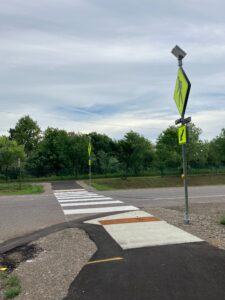Background
Esko, MN is a small place. Not a town, not a village, but a “census designated place” that falls within the legal boundaries of Thomson Township, which is itself small: less than 40 square miles and home to about 5,000 people.
But what it lacks in size, Esko makes up for in spirit, exemplified by the dogged determination of a local Girl Scout troop to improve pedestrian safety at a high-traffic crosswalk.
It all started back in 2019 when one of the troop members participated in a safety program that included helping pedestrians navigate a different crosswalk. Noticing a distinct lack of driver compliance and care prompted her to consider other crosswalks in the area, including one at Canosia Road and Belmar Lakne, which connects a popular park to sports fields and a walking/cylcling path, and where a 12-year-old girl was struck and killed.
Project requirements
 Although the Canosia/Belmar crossing already had several safety countermeasures in place—MUTCD-compliant crosswalk signage, longitudinal “zebra” style pavement markings, a reduced speed limit, advance warning signs—many drivers had become habituated to them and paid little attention.
Although the Canosia/Belmar crossing already had several safety countermeasures in place—MUTCD-compliant crosswalk signage, longitudinal “zebra” style pavement markings, a reduced speed limit, advance warning signs—many drivers had become habituated to them and paid little attention.
The scouts began to research other safety solutions and quickly came across the rectangular rapid flashing beacon (RRFB), which uses high-intensity, pedestrian-actuated flashing light bars to alert drivers to crossing pedestrians. According to the FHWA, RRFBs can reduce pedestrian crashes up to 47% and increase motorist yielding rates up to 98%.
With numbers in hand, the group began to write letters to local officials advocating for the installation of RRFBs. Time and again the response came back the same: the technology was too expensive, with one local engineer estimating the total cost of the project at $8,000 to $15,0000.
Our solution
Carmanah became involved with the project in 2021, after Thomson Town Board Supervisor Bill Gerard reached out and explained the scouts’ predicament (they had taken to fundraising themselves, but efforts had, again, been hampered by the pandemic).
 Carmanah’s team quickly began sizing up the crosswalk, considering the number of anticipated system activations, flash duration, and geographic position. Even with its relatively northern latitude—in winter, Esko sees an average of 13F and 2.5 peak sun hours in December—they determined that solar would be achievable, providing greatly reduced utility and installation costs.
Carmanah’s team quickly began sizing up the crosswalk, considering the number of anticipated system activations, flash duration, and geographic position. Even with its relatively northern latitude—in winter, Esko sees an average of 13F and 2.5 peak sun hours in December—they determined that solar would be achievable, providing greatly reduced utility and installation costs.
Another factor that helped keep costs down was the size of the system. After careful consideration, Carmanah and its Minnesota distributor Mobotrex were able to recommend the manufacturer’s most compact R920-E with an ADA-compliant Polara Bulldog push button, due in large part to the fact that the system’s solar panel had recently been upgraded to 15 watts, greatly improving its performance.
Outcome
It’s been three years since the Girl Scouts began writing letters to local officials and their hard work has finally paid off: In August 2023, two R920-E crosswalk systems were installed by county technicians.
Already the RRFBs have facilitated hundreds of safe crossings and thanks to the tireless efforts of the girl guides, they’re sure to help thousands more. “It’ll keep people safer, and maybe it’ll make people drive more carefully,” said Girl Scout Carli Bloom. “It helps drivers see more to stop and it really helps bring safety to the community.”
